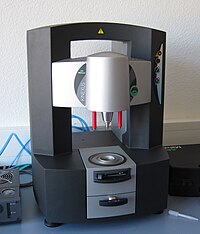
Photo from wikipedia
Abstract A general framework for Maxwell-Oldroyd type differential constitutive models is examined, in which an unspecified nonlinear function of the stress tensor and rate-of-deformation tensor is incorporated into the well-known… Click to show full abstract
Abstract A general framework for Maxwell-Oldroyd type differential constitutive models is examined, in which an unspecified nonlinear function of the stress tensor and rate-of-deformation tensor is incorporated into the well-known corotational version of the Jeffreys model discussed by Oldroyd. For medium amplitude simple shear deformations, the recently developed mathematical framework of medium amplitude parallel superposition (MAPS) rheology reveals that this generalized nonlinear Maxwell model can produce only a limited number of distinct signatures, which combine linearly in a well-posed basis expansion for the third order complex viscosity. This basis expansion represents a library of MAPS signatures for distinct constitutive models that are contained within the generalized nonlinear Maxwell model. We describe a framework for quantitative model identification using this basis expansion for the third order complex viscosity, and discuss its limitations in distinguishing distinct nonlinear features of the underlying constitutive models from medium amplitude shear stress data. The leading order contributions to the normal stress differences are also considered, revealing that only the second normal stress difference provides distinct information about the weakly nonlinear response space of the model. After briefly considering the conditions for time-strain separability within the generalized nonlinear Maxwell model, we apply the basis expansion of the third order complex viscosity to derive the medium amplitude signatures of the model in specific shear deformation protocols. Finally, we use these signatures for estimation of model parameters from rheological data obtained by these different deformation protocols, revealing that three-tone oscillatory shear deformations produce data that is readily able to distinguish all features of the medium amplitude, simple shear response space of this generalized class of constitutive models.
Journal Title: Journal of Non-newtonian Fluid Mechanics
Year Published: 2021
Link to full text (if available)
Share on Social Media: Sign Up to like & get
recommendations!